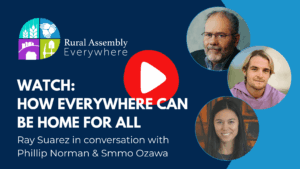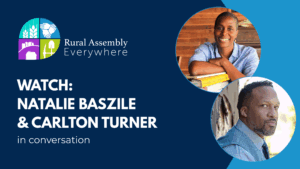This year, Center for Rural Strategies fellow Quintissa Peake has represented the Rural Assembly at events throughout the country. She reflects here on her experience at the National Rural Health Association Health Equity Conference earlier this year in New Orleans.

By Quintissa S. Peake
I had the privilege of attending the National Rural Health Association’s (NRHA) Health Equity Conference in New Orleans, Louisiana, on May 6-7, 2024. This remarkable event brought together healthcare professionals, policymakers, and advocates, all dedicated to advancing health equity in rural America. As a first-time attendee, I was impressed by the diverse breakout sessions and the wealth of knowledge shared by the speakers. The sessions addressed various aspects of rural health disparities, with inspiring keynote speakers providing valuable insights into health equity. A key theme was the importance of considering intersectionality, recognizing how factors such as race, gender, socioeconomic status, and geography intersect to influence health outcomes.
Several compelling statistics and facts highlighted the importance of this conference:
- According to the Centers for Disease Control and Prevention (CDC), people living in rural areas are more likely to die from heart disease, cancer, unintentional injury, chronic lower respiratory disease, and stroke than their urban counterparts.
- Approximately 20% of the U.S. population resides in rural areas, yet only about 10% of physicians practice in these regions, creating significant barriers to accessing healthcare services.
- Telehealth usage in rural areas has increased by over 50% since the COVID-19 pandemic, indicating a positive trend towards leveraging technology to overcome geographical barriers.
Attending this annual gathering provided me with a unique perspective. A few sessions at this year’s Health Equity Conference focused on two critical health crises disproportionately affecting rural communities: the opioid epidemic and mental health issues. Mental health services are severely lacking in rural and frontier regions, with many communities having no resident mental health providers. This shortage leads to higher rates of untreated mental health conditions, including depression and substance use disorders. It’s estimated that nearly 80% of rural communities are designated as Mental Health Professional Shortage Areas.
One particularly impactful session I attended was “Beyond Incarceration: Improving Outcomes for Women and Families affected by Substance Use Disorder.” Part of this session featured a presentation on expanding access to Oklahoma’s innovative MOUD (Medication for treatment of Opioid Use Disorder) program across county jails. The goal of this telehealth program was to reduce recidivism and opioid overdose deaths in incarcerated pregnant women. It was also provided at no cost to the jail and the participant. Hearing firsthand accounts of these success stories was both emotional and moving.
Overall, the conference was an enlightening and inspiring experience, reinforcing the importance of ongoing efforts to achieve health equity for all, regardless of geographical location. It underscored that advancing rural health equity requires understanding the unique challenges faced by rural populations. As we look to the future, it is essential to continue advocating for policies that address the critical shortages in rural healthcare services. My experience at the Health Equity Conference has fueled my passion for this cause, and I look forward to applying the insights gained to my work and advocating for meaningful change. The collective efforts of everyone involved in this conference can pave the way for a more equitable and healthier rural America.






